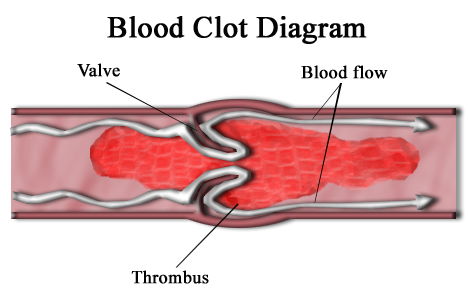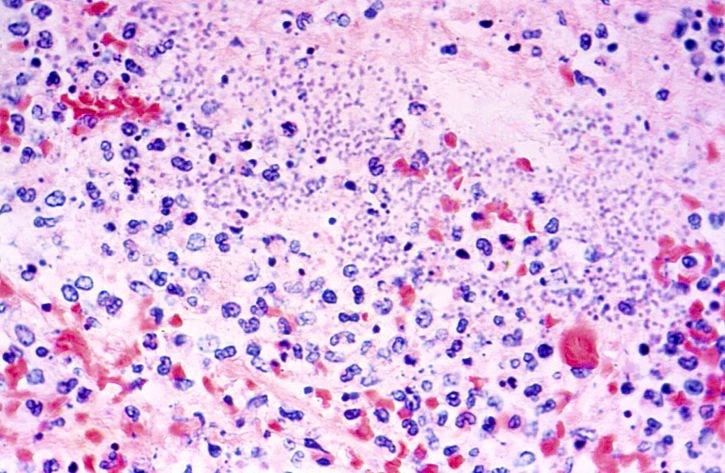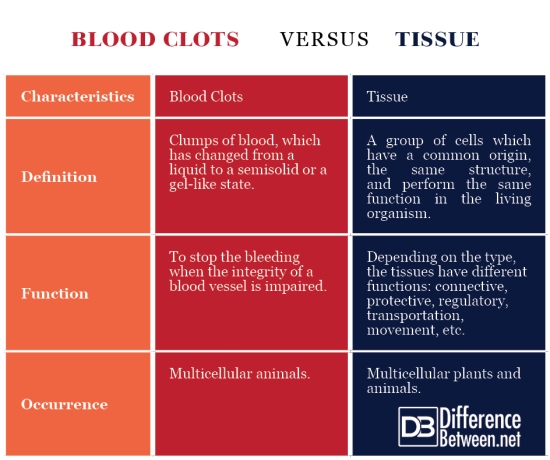Difference Between Blood Clots and Tissue
What is Blood Clots?
Blood clots are clumps of blood, which has changed from a liquid to a semisolid or gel-like state. The blood clots are the end product of the hemostasis – the bleeding termination process. They are produced by the accumulation of platelets.
The ability of blood to thicken and to clot is vital to survival. When the integrity of a blood vessel is impaired, platelets in the blood become sticky and accumulate around the site of the injury, forming a blood clot. In a healthy condition and undamaged integrity of the blood vessels, clots should not be formed.
Blood clots become dangerous when they appear in normal and not injured blood vessels or do not dissolve after they have fulfilled their function. These clots are of two types:
- Thrombus – a blood clot that forms near the wall of the heart or a blood vessel. This type of clot may slow down the flow of the blood, and if it grows enough, it can stop the flow of blood into the affected blood vessel.
- Embolus – a blood clot that forms in one part of the body, moves with the bloodstream and is stuck in another blood vessel. Emboli occur less frequently but are more dangerous because they can cause a sudden blockage of the bloodstream, which can be fatal. Embolism that arises in an artery stops blood flow to a certain organ or tissue and can cause tissue damage or even death.
Factors that contribute to the formation of blood clots in non-injured blood vessels are inflammation of the veins, blood diseases, genetic factors, diet, prolonged sitting, varicose veins, pregnancy, childbirth, sickle cell anemia, smoking, overweight, liver diseases and disorders in the cardiovascular system.
What is Tissue?
In multicellular organisms, the cells are structurally and functionally interconnected, forming tissues. Tissue is a set of cells which have a common origin, the same structure, and perform the same function in the living organism.
In the body, different types of tissues can form a common structure – organ (heart, stomach, kidneys, lungs, etc.). In organs, different tissues work together, but each has its own structure and functions.
There are two main types of tissues in plants – meristematic and permanent tissues.
The cells in meristematic tissues have the ability to divide, thus leading to the growth and formation of new organs throughout the life of the plants. According to their origin, there are two types of meristematic tissues:
- Primary meristematic tissues – originated from the germ of the seed;
- Secondary meristematic tissues – originated from the permanent tissues.
Permanent tissues are a set of cells that are differentiated and specialized to perform a certain function but have lost their ability to divide. Depending on their functions, permanent tissues are:
- Parenchyma – least differentiated, often with a variety of functions. The cells are simple, alive, with thin cell walls;
- Conducting tissue- involved in the delivery or export of various chemical substances to/from particular parts of the plant;
- Mechanical tissue – gives elasticity, strength, and stability to the whole plant;
- Protective tissue – covers the plant without hindering the possibility to exchange substances with the environment.
The animals have four main types of tissues:
- Muscle tissue – under the influence of certain signals (nervous impulses) can be shortened and thus move individual parts of the body or the whole organism into space;
- Nervous tissue -performs the coordination of multiple processes in the body, including muscle contraction;
- Connective tissue – provides connectivity between the other tissue types. The connective tissue provides the mechanical resistance, physiological and metabolic homeostasis of the plants;
- Epithelial tissue – carries out the protection of organs and the body as a whole, without obstructing the secretion and absorption of substances. These are the outermost layers covering the body, the digestive tract and other organs.
Each of the tissue types has different subtypes. They are characterized by a different structure depending on the specific functions they perform.
Difference Between Blood Clots and Tissue
Definition
Blood clots: Blood clots are clumps of blood, which has changed from a liquid to a semisolid or a gel-like state.
Tissue: Tissue is a group of cells which have a common origin, the same structure, and perform the same function in the living organism.
Function
Blood clots: The function of the blood clots is to stop bleeding when the integrity of a blood vessel is impaired.
Tissue: Depending on the type, the tissues have different functions, like connective, protective, regulatory, transportation, movement, etc.
Occurrence
Blood clots: Blood clotting occurs only in multicellular animals.
Tissue: Both multicellular plants and animals are made up of tissues.
Blood Clots Vs. Tissue
Summary of Blood Clots Vs. Tissue
- Blood clots are clumps of blood, which has changed from a liquid to a semisolid or a gel-like state.
- Tissue is a group of cells which have a common origin, the same structure, and perform the same function in the living organisms.
- The function of the blood clots is to stop bleeding when the integrity of a blood vessel is impaired.
- Depending on the type, the tissues have different functions, like connective, protective, regulatory, transportation, movement, etc.
- Blood clotting occurs only in multicellular animals, while both multicellular plants and animals are made up of tissues.
- Difference Between Gallstones and Cholecystitis - September 5, 2021
- Difference Between Constipation and Cramping - August 4, 2021
- Difference Between Whole Genome Sequencing and Microarray - May 6, 2021
Search DifferenceBetween.net :
Leave a Response
References :
[0]Image credit: https://upload.wikimedia.org/wikipedia/commons/c/c5/Blood_clot_diagram.png
[1]Image credit: https://pixnio.com/science/microscopy-images/plague-yersenia-pestis/photomicrograph-of-lung-tissue-revealing-yersinia-pestis-organisms
[2]Neuhaus, Gunther. Morphology and Anatomy of Vascular Plants. Berlin: Springer. 2013. Print.
[3]Nachev, N. Gynecology. A Textbook for Students in Medicine. Sofia: Arso. 2000. Print.
[4]Junqueira, L., J. Carneiro, R. Kelley. Basic Histology 9th Edition. New York: McGraw Hill. 2003. Print.



